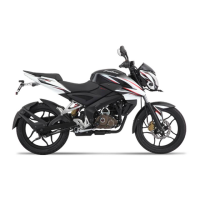
Do you have a question about the Pulsar NS 150 and is the answer not in the manual?
| Displacement | 149.5 cc |
|---|---|
| Compression Ratio | 9.8:1 |
| Fuel System | Carburetor |
| Cooling System | Air Cooled |
| Transmission | 5-speed |
| Clutch | Wet Multi-plate |
| Front Tyre | 80/100 - 17 |
| Rear Tyre | 100/90 - 17 |
| Length | 2012 mm |
| Height | 1060 mm |
| Seat Height | 805 mm |
| Kerb Weight | 144 kg |
| Engine Type | Single cylinder, 4-stroke, SOHC |
| Maximum Power | 14 PS @ 8500 rpm |
| Ignition | CDI |
| Front Suspension | Telescopic |
| Rear Suspension | Monoshock |
| Front Brake | Disc 240 mm |
| Rear Brake | Drum 130 mm |
| Fuel Tank Capacity | 12 L |
Details engine displacement, power, torque, and fuel tank capacity.
Covers vehicle dimensions, wheelbase, tyre sizes, and pressures.
Explains where to find the vehicle's frame serial number.
Details the location of the engine serial number.
Labels key external components of the Pulsar NS 150 model.
Describes the LOCK, OFF, and ON positions of the steering lock.
Details the procedure for locking and unlocking the steering.
Instructions on how to open and lock the fuel tank cap.
Explains the ON, RES, and OFF settings for the fuel tap.
Explains the meaning of various indicators on the speedometer display.
How to reset the trip meters using mode and set buttons.
Procedure for resetting the service reminder indicator.
Explains High/Low beam, Turn Signal, Horn, and Pass switches.
Steps to remove the rear seat to access the tool kit.
Where the tool kit is located and how to secure it.
Details the process for removing the front seat.
Identifies the battery's location and refers to its maintenance.
Guides on fitting the front seat to the chassis.
Steps for correctly installing the rear seat.
Essential items to check before riding the motorcycle daily.
Steps for starting the engine, including choke usage.
Guidance on shifting gears and starting from a stop.
Advice on helmet use, rules, braking, and weather conditions.
Specific recommendations for maintaining the bike in rainy conditions.
Specifies the correct engine oil type and capacity.
How to check and maintain the engine oil level.
Steps to remove the front wheel assembly.
Advice on repairing punctures and maintaining tyre pressure.
Highlights battery features and how to keep it healthy.
Advice on storing the vehicle and battery care.
Details on spark plug removal, cleaning, and gap settings.
How to check and adjust the drive chain slack.
Location of reservoirs and how to check fluid levels.
Guidance on when and how to replace brake fluid.
Details operations and frequencies for initial servicing up to 7th service.
Continues the maintenance schedule and lubrication points.
Final part of the maintenance chart, including lubricants and checks.
Steps for preparing the vehicle for long-term storage.
Actions needed to bring the vehicle back into service.
